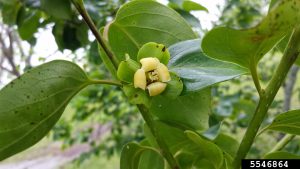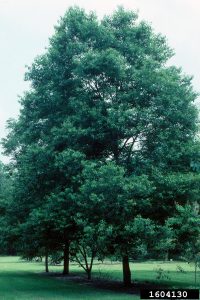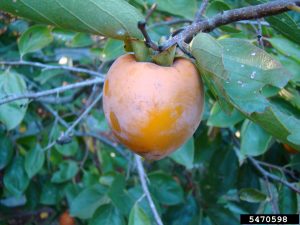Persimmon, Diospyros virginiana

Photo by Rebekah D. Wallace, University of Georgia, Bugwood.org

Photo by John Ruter, University of Georgia, Bugwood.org

Photo by Rebekah D. Wallace, University of Georgia, Bugwood.org
Height: 30 to 60 feet
Spread: 15 to 25 feet
LANDSCAPE USE
Performs well as a specimen tree, in poor soil along roads and fence lines, or in naturalistic landscapes. Also, a good choice for parks and golf courses.
FORM
An erect, straight-trunked, deciduous, tree with a typically oval form, spreading branches, brightly colored fruit, and dark, blocky, bark that is high in character.
NATIVE RANGE
Hammocks, flatwoods, fields, upland woods, bottomlands. Southern New England west to Ohio, south to and nearly throughout Florida, and west to eastern Texas.
CHARACTERISTICS
Flowers: Whitish to greenish or yellowish green, inconspicuous, borne in small clusters in the leaf axils. Male and female flowers borne mostly on separate trees. Spring.
Leaves: Alternate, simple, to about 6 inches long, glossy above, hairy below, turning golden or reddish in fall.
Fruit: A several-seeded, globose, yellowish, 1 – to 2-inch-diametcr, fleshy berry. Edible but very sour and pungent before fully ripe.
Mature fruit is very sweet.
Bark: Dark brown; that of mature trees divided into small, attractive, rectangular blocks.
CULTURE
Soil: Very adaptable from wet to dry, poor soil.
Exposure: Full sun to part shade. Water: Perform well in moist to quite dry situation.
Hardiness Zones: 4-10.
Life Span: Long-lived; at least 100 years
BEST FEATURES including WILDLIFE SUPPORT
The bark of older trees has great character. Fruit is relished by wildlife. Persimmon is a host for many moth species that are in turn great bird food. This tree is dioecious, so you must have males and females in proximity to get fruit on the female trees. Adapts to relatively poor soil. Fast growing. Fall color.
COMPANION PLANTS
Sourwood (Oxydendrum arboreum), Sugarberry (Celtis laevigata), Flowering Dogwood (Cornus florida), Redbud (Cercis canadensis), Fringetree (Chionanthus virginicus), Red Bay (Persea borbonia), American Holly (Ilex opaca), Wild Olive (Osmanthus americanus), Sand Live Oak (Quercus geminata), Sparkleberry (Vaccinium arboreum), Wild Lime (Zanthoxylym fagara).
DISADVANTAGES
Subject to leaf spot and tent caterpillars, the latter of which can be a nuisance but also feed birds. Plants that produce heavy fruit crops require cleanup in formal landscapes. Difficult to transplant due to a large taproot. It has a relatively long dormancy period.
CULTIVARS
Numerous cultivars are known.
SIMILAR AND RELATED SPECIES
Few native trees can be confused with the Persimmon, although Black Cherry (Prunus serotina) and Flowering Dogwood (Cornus florida) also have blocky bark.